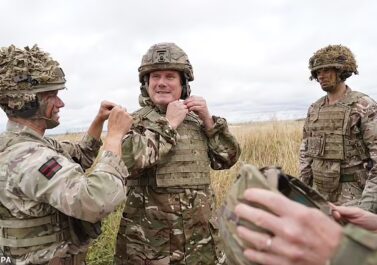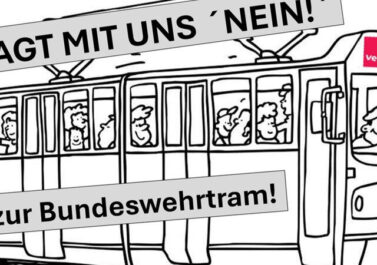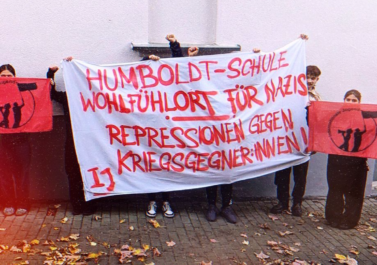
The last attempt within AngryWorkers to reassess the situation of the war in Ukraine was made after 100 days of war. In early February, after an entire year of bloodshed and mass destruction, we will meet for an internal weekend discussion about the war and our position towards it.
We translated the following text as material for this discussion. The article doesn’t talk about the wider background of the dispute, but rather about the current phase of the war. Still, we can use this momentary snapshot in order to discuss the questions that arose for us at the beginning of the war, e.g. if there is scope for an independent working class defence within the military confrontation, or if western weapon supplies can lead to a quicker end to the war.
The more recent context of the article is the current debate about whether or not to send more tanks to Ukraine, with pressure on Germany to fulfil its role as a ‘new’ military force – within a geopolitically charged atmosphere.
———
Kiev’s missed opportunity?
By Tomasz Konicz
A new turning point looms in the war over Ukraine – and further escalation with incalculable consequences
konicz.info, 01/19/2023
In retrospect, the recapture of the southern Ukrainian city of Kherson by the Ukrainian army in November 2022, is likely to be identified as the irretrievably lost moment when optimal conditions for serious peace talks prevailed. [1] The invading [Russian] forces’ morale was at rock bottom after the humiliating defeat, while the Kremlin’s signals to that effect culminated in an official offer of negotiations by Putin in December. [2] At the time, Kiev turned down a potential deal with the Kremlin. Meanwhile, a law prohibits the Ukrainian president from participating in negotiations with Moscow, as long as Putin is in office.
The Kherson triumph was preceded by the successful lightning offensive in Kharkov oblast, [3] where Russian forces literally collapsed and vast territories were recaptured by Ukrainian forces within days. The Ukrainian victory in Kharkov oblast marked a turning point in the war. At this point, the strategic initiative passed to Ukraine, and Kiev determined the course of the war, while Russia was militarily on the defensive and could only react. But the recapture of Kherson was laborious, protracted and bought with very high losses of men and material for the Ukrainian army – and it was only possible in view of the cutting of the Russian supply lines by destroying the bridges over the Dnieper with artillery. [4]
Now, just over two months after the Russian withdrawal from Kherson, it is the Ukrainian army that has had to retreat with heavy losses from the mining settlement of Soledar, north of the town of Bachmut, which has been contested for months. [5] The mercenary troops of Kremlin oligarch Yevgeny Prigozhin were able to encircle Ukrainian formations while capturing the small town. These troops have been completely obliterated after they refused to surrender. Russian Telegram channels are full of videos of hundreds of Ukrainian soldiers killed in Soledar. Both sides have lost thousands of soldiers and large amounts of material in the battle. The war has long since become a war of attrition, with the Kremlin expecting “Ukraine to run out of resources first,” as one insider told the Financial Times. [6]
It is the Verdun logic of “bleeding white” the enemy [i.e. cutting supplies] that is applicable in this phase of war. In 1916, Chief of General Staff, Erich von Falkenhayn, wanted to literally strip the French army of its “human material” in the battle of attrition around the iconic site, which was to be literally shot to pieces in an industrial process of annihilation. The situation is similar on the frontlines of Bachmut, which has long since become a symbol of the war in eastern Ukraine. Ukraine has been able to build a solid, static line of defence in the Donbass for years – since as far back as the 2014 civil war – which has now been breached at Soledar. However, once such a static frontline of fortified defence has been partially breached, it must be abandoned as a whole in the medium term and a new line of defence built, otherwise the entire front can be “rolled up” by flank attacks. A new defence line is already being built near Kramatorsk/Slovyansk.
That is why the Ukrainian army is trying so desperately to prevent the Russian breakthrough at Soledar by all means, which makes a withdrawal from Bachmut a mere question of time. And both sides are doing this with the use of human war material. New units must ceaselessly be thrown into the battle to close the gap in the front or expand the breakthrough, while the other side blasts them to pieces using drone-assisted tracking and artillery strikes. Most of the dead in this war are victims of artillery shells that never saw an enemy in close combat. Without exaggeration, it can already be stated that this war will claim hundreds of thousands of lives. The rapidly expanding cemeteries of Ukraine currently resemble a sea of flags, where new graves for the fallen must be permanently dug. [7]
Both sides have already lost thousands of soldiers in the battle for Soledar alone, but the Kremlin has apparently managed to stabilise its military machine after the disasters and catastrophes of recent months. Even if the sluggish and corrupt military apparatus still makes serious mistakes at times, costing the lives of hundreds of conscripted reservists, [8] the supply situation of Russian army units has at least eased. The catastrophic shortages that characterised the first months of the war have clearly been alleviated by an improvement in Russian logistics.
The idea that Russian terrorist attacks on Ukraine’s civilian infrastructure would be brought to an end by a missile shortage has been proven wrong by the latest wave of attacks in mid-January, in which dozens of targets were hit. [9] The most severe damage is inflicted on Ukraine’s infrastructure by launching winter attacks on energy supplies, as prolonged power outages during freezing periods destroy water and sewage systems due to burst pipes. Billions of dollars worth of damage can occur in this process.
Furthermore, the Kremlin is now gearing up the Russian economy for a long war, while the reorganisation efforts of the military administration and infrastructure is supposed to lead to a permanently higher mobilisation rate in terms of military personnel. The Kremlin is already thinking in terms of the war in years: The number of Russian military personnel is to be increased from one million to 1.5 million by 2026. [10] In this context, the Institute for the Study of War (ISW) speaks of organisational steps to enable Russia to fight a “major conventional war. ” [11] According to ISW, a “decisive strategic action” by the Russian army to turn the tide of the war is expected in the next six months.
The Russian partial mobilisation of 300,000 reservists is now nearly complete, despite all the frictions and shortcomings. This means that the Russian military leadership can discuss various options for a Russian offensive. Meanwhile, Russian troop concentrations in Belarus are forcing Ukraine to deploy army units urgently needed in the east to protect the border in the northwest. Russia recently stated that a “Ukrainian attack” on Russia or Belarus could lead to a collective military response by both countries – it is a deliberately vague free-for-all for Belarus to enter the war. [12] Other scenarios consider a Russian attack from the south likely, which would occur east of the Dnieper River toward Zaporizhzhya and Pavlograd, or from the north, from Russia’s Belogrod region, to stab the Ukrainian front in Kharkov and Luhansk oblasts in the back.
Russia has much greater military and economic potential than Ukraine, and it was the megalomania, cronyism, and pervasive corruption of the Putin state oligarchy that led to the Russian disasters in the first year of the war. But in the meantime, the Kremlin’s efforts to mobilise these superior resources appear to have been at least partially successful. In plain language, the Kremlin will win the war in the medium term if the West is not prepared to take a further escalatory step – to supply heavy war equipment such as tanks, attack helicopters and combat aircraft on a massive scale. That is why the discussion about it is gaining momentum in the Western public. [13] It is an implicit admission that the balance of the war threatens to tip in Russia’s favour.
The Ukrainian army, like Russia, has suffered major losses in men and material resources, with few options to replace them. It makes military sense for Kiev to demand German tanks and U.S. armoured vehicles from the West in order to transition back to a war of movement. If the tide of war is not to tip, then the West must indeed greatly expand arms deliveries. The delivery of the British tanks to Kiev is only a trial balloon in this regard, [14] in order to get Berlin to agree to the Leopard deliveries. Only a few examples of the British Challenger 2 were exported, and no military infrastructure exists for this tank, whereas the Leopard 2 was an export hit that many countries could supply to Ukraine – along with spare parts, ammunition and maintenance material. [15]
Where this stepping up of escalation might lead to became clear by reactions of Russian Duma deputies regarding the potential delivery of German tanks, who called for general mobilisation in such a case. [16] The brutal truth is that there is no “good” exit from this imperialist war. [17] Either there will be a dirty geopolitical deal between the West and the Kremlin, in which parts of eastern Ukraine are de facto incorporated into the Russian empire while the rest of the country is added to the Western sphere of influence, or the spiral of escalation will continue, the conflict will escalate until the war gets completely out of control. With the impending loss of Crimea the nuclear option will become acute.
The loss of control can thus take the form of a nuclear exchange of blows, since Russia ultimately has the short end of the stick in this conventional escalation spiral vis-à-vis Nato. But the nuclear Armageddon can also take place in interaction with an increased erosion of the state. The cracks in the state power structure are clearly visible in authoritarian Russia in particular. The war exposed precisely the internal disruption and erosion of the Russian state. This process of erosion is already gripping its military core. In general, authoritarian state structures are not a sign of strength, but a sign of socio-economic weakness, which can only be covered up for a time by mere dictatorial means and coercion.
The failure of the corruption-ridden Russian army contrasts with the success of the post-state military actors: the Wagner mercenary force around Kremlin favourite Prigozhin, who is now in open competition with the army leadership, or the troops of the Chechen ruler Kadyrov. The latter has in effect established a post-modern principality in the Caucasus, which is only formally under Moscow’s control as long as Kadyrov performs his military vassal service for the Kremlin. The formation of parallel power structures that belie the appearance of a state monopoly on the use of force is likely to progress in Russia as the war continues. It is also fundamentally wrong to think of Putin as an all-powerful autocrat, as he rather plays a mediating role between the various rackets and clans of the Russian state oligarchy. [18]
But similar centrifugal forces are likely at work in the Ukrainian state apparatus, which was a mere plaything of oligarchic interests even before the outbreak of war. [19] A brief glimpse into the power struggles in Kyiv was provided by the dismissal of Ukrainian presidential advisor Oleksiy Arestovych, who was officially forced to resign because of his comments on the deadly Russian missile attack in Dnipro. [20] Arestovych initially stated that the Russian missile that destroyed a high-rise building in Dnipro and killed dozens of civilians had been shot down by Ukrainian air defences. Earlier, Arestovych had been critical of Ukraine’s wartime identity politics in an interview. According to the interview, the Ukrainian right is conducting a nationalist campaign to suppress Russian and “post-Soviet” identities in eastern Ukraine, which is alienating many Russian-speaking Ukrainians from the government in Kiev (the interview is shared primarily by pro-Russian accounts). [21] The right-wing extremist groups that are gaining influence and sometimes officially become part of the armed forces [22] are likely to be the greatest Ukrainian instability factor in the course of the war in the future.
The Ukrainian chances of still achieving decisive gains in terrain against Russia are – below the threshold of a major war between East and West – vanishingly small, while the casualty figures of this imperialist war will rise higher and higher with every step of escalation. This increase in casualties is visible both in terms of human lives and in terms of the devastation of the infrastructure in general of the eastern Ukrainian cities. These cities are being developed as central defence points by the Ukrainian army, as the army here is particularly experienced in urban warfare. Moreover, the war not only leads to the devastation of entire regions in the east, it also accelerates state and social erosion processes. These processes are propelled by the general crisis, interacting with anomic centrifugal forces and authoritarian formation. [23]
And yet it remains questionable whether even a dirty imperialist deal, in which Ukraine would in effect be divided between West and East, is still a realistic option at all. Putin set himself a minimum official target for his imperialist land grab when he put the sham referendums on the accession of four Ukrainian administrative regions to the Russian Federation to a vote. However, the Donbass, Kherson and Zaporizhzhya are only partly under Russian control. Without the Donbass and Kherson, the Kremlin can hardly sell the disastrous course of the war – which devours vast amounts of resources, material and money and is associated with very high losses – as a victory. In Kiev, on the other hand, any attempt at serious negotiations with the Kremlin is likely to meet with resistance from the far right, which is armed to the teeth. [24] And even the West is divided on the issue: the USA, Britain and Russia’s eastern neighbours – above all Poland – want to continue the war, while Germany and France would be willing to make a deal with Moscow. [25]
The socio-ecological crisis of capital, the interlocking of the inner and outer limits of capital accumulation, the overproduction crisis prolonged by debt-making, like the climate and resource crisis, is fuelling this geopolitical, imperialist willingness for confrontation of the state monsters more and more. The resources, the fertile black earth soils of Ukraine will become more and more important as the ecological crisis intensifies. The Kremlin is also literally fighting for the existence of its eroding empire, shattered by social tensions, [26] while the over-indebted US must counter-assert the dollar as the world’s reserve currency and its position as hegemon. This war, which is gaining momentum, between Oceania (Washington’s Atlantic and Pacific alliance system) and Eurasia (China including Russia) is currently raging only in Eastern Europe, but, in the future, a second front may also emerge in Southeast Asia, in Taiwan.
———
I finance my journalistic work largely through donations. If you like my texts, you are welcome to contribute – either via Patreon, via Substack, or by direct bank transfer after consultation by mail:
https://www.patreon.com/user?u=57464083
Footnotes
1 https://www.tagesspiegel.de/politik/ukraine-offensive-tag-261-kiews-strategische-glanzleistung-in-cherson-8866336.html
2 https://www.voanews.com/a/putin-says-russia-ready-to-negotiate-over-ukraine-/6890944.html
3 https://www.konicz.info/2022/09/09/wendepunkt-in-der-ukraine/
4 https://www.nytimes.com/2022/09/24/world/europe/ukraine-south-kherson-russia.html
5 https://www.zdf.de/nachrichten/politik/bachmut-soledar-ukraine-krieg-russland-100.html
6 https://www.ft.com/content/d759e24b-dd48-4adc-a0ae-7e53b89e5231
7 https://www.youtube.com/watch?v=1c9dtEeb6EY
8 https://www.bbc.com/news/world-europe-64142650
9 https://www.aljazeera.com/news/liveblog/2023/1/14/russia-ukraine-live-russian-missiles-hits-infrastructure-in-kyiv
10 https://kyivindependent.com/news-feed/russian-defense-ministry-confirms-plan-to-expand-army-to-1-5-million-troops
11 https://www.understandingwar.org/backgrounder/russian-offensive-campaign-assessment-january-15-2023
12 https://www.thedailybeast.com/russia-sets-ultimatum-for-top-ally-belarus-to-formally-join-vladimir-putins-war-in-ukraine?ref=scroll
13 https://www.thedailybeast.com/why-russia-is-terrified-of-americas-patriot-missiles-delivery-to-ukraine
14 https://www.zdf.de/nachrichten/politik/challenger-grossbritannien-ukraine-krieg-russland-100.html
15 https://www.handelsblatt.com/politik/deutschland/ukraine-krieg-deutschland-bereitet-sich-auf-leopard-lieferung-fuer-ukraine-vor/28924168.html
16 https://twitter.com/WarMonitors/status/1614999689304363009
17 https://www.konicz.info/2022/06/23/was-ist-krisenimperialismus/
18 https://www.konicz.info/2022/05/25/rackets-und-rockets/
19 https://www.konicz.info/2022/06/20/zerrissen-zwischen-ost-und-west/
20 https://www.bbc.com/news/world-europe-64304310
21 https://twitter.com/e_l_g_c_a/status/1615138445051195392
22 https://twitter.com/militarylandnet/status/1526132364702887936
23 https://www.konicz.info/2022/05/24/eine-neue-krisenqualitaet/
24 https://twitter.com/militarylandnet/status/1526132364702887936
25 https://www.welt.de/politik/ausland/plus243059565/Ukraine-Krieg-Der-Riss-in-der-Nato-zeigt-sich-an-Deutschland-und-Polen.html
26 https://www.konicz.info/2022/01/18/neoimperialistisches-great-game-in-der-krise/



